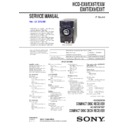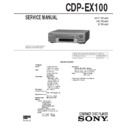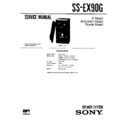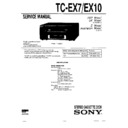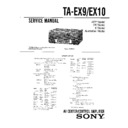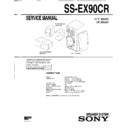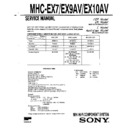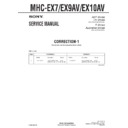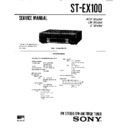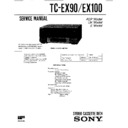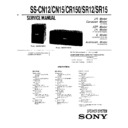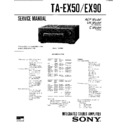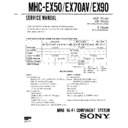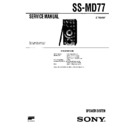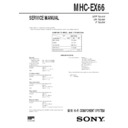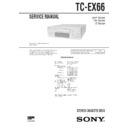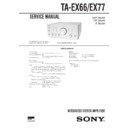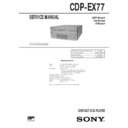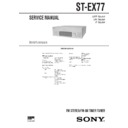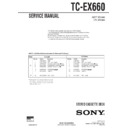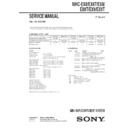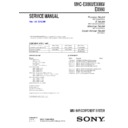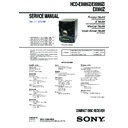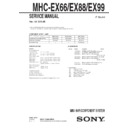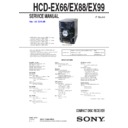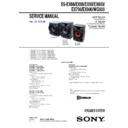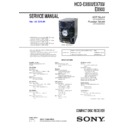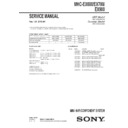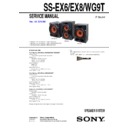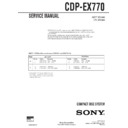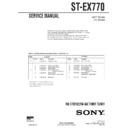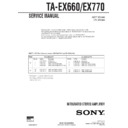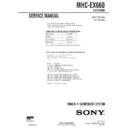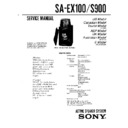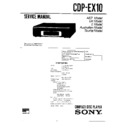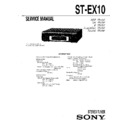Read Sony HCD-EX6 / HCD-EX6T / HCD-EX8 / HCD-EX8T / HCD-EX9 / HCD-EX9T / MHC-EX6 / MHC-EX6T / MHC-EX8 / MHC-EX8T / MHC-EX9 / MHC-EX9T Service Manual online
(HCD-EX6T/EX8T/EX9T)
60 Hz (Mexican model)
The following measured at AC 220 V,
50/60 Hz (Argentine model)
The following measured at AC 120 V,
220 V, 240 V, 50/60 Hz (Other models)
Power output (rated):
Low
High
RMS output power (reference):
Low
RMS output power (reference):
Low
High
Low
RMS output power (reference):
HCD-EX9/EX9T/EX8/EX8T:
impedance
Laser Diode Properties
Signal-to-noise ratio: More than 90 dB
Dynamic range: More than 88 dB
EX8T/EX6T only)
Antenna:
Tuning range:
Tuning range
Latin American models:
other countries.
2-2. Top Panel Section ........................................................... 7
2-3. Tape Mechanism Deck (HCD-EX6T/EX8T/EX9T) ....... 8
2-4. Front Panel Section ......................................................... 8
2-5. MAIN
2-7. CD Mechanism Section .................................................. 11
2-8. Belt
6-2. Block Diagram –Tape/Audio Section– ........................... 22
6-3. Block Diagram –Display/Power Supply Section– .......... 23
6-4. Printed Wiring Board –CD Section– .............................. 24
6-5. Schematic Diagram –CD Section– ................................. 25
6-6. Printed Wiring Board –USB Section– ............................ 26
6-7. Schematic Diagram –USB Section– ............................... 27
6-8. Printed Wiring Board –Panel Section– ........................... 28
6-9. Schematic Diagram –Panel Section– .............................. 29
6-10. Printed Wiring Board –USB-JACK Section– ................. 30
6-11. Schematic Diagram –USB-JACK Section– .................... 30
6-12. Printed Wiring Boards –MAIN-AMP Section– .............. 31
6-13. Schematic Diagram –MAIN-AMP Section (1/2)–.......... 32
6-14. Schematic Diagram –MAIN-AMP Section (2/2)–.......... 33
6-15. Printed Wiring Board –Power Supply Section– ............. 34
6-16. Schematic Diagram –Power Supply Section– ................ 35
6-17. Schematic Diagram –Tape Deck Section
(HCD-EX6T/EX8T/EX9T)–
(HCD-EX6T/EX8T/EX9T)–
7-3. Top Panel Section (HCD-EX6T/EX8T/EX9T) .............. 48
7-4. Chassis
7-6. CD Mechanism Section (CDM88CL-D1BD74UR) ....... 51
•
aged by heat.
•
repairing.
circuit board (within 3 times).
or unsoldering.
REPLACE THESE COMPONENTS WITH SONY PARTS
MANUAL OR IN SUPPLEMENTS PUBLISHED BY SONY.
Mexican
Power consumption
HCD-EX9/EX9T:
change without notice.
Use of controls or adjustments or performance of procedures
other than those specifi ed herein may result in hazardous radia-
tion exposure.
a CLASS 1 LASER product.
This marking is located on the
rear exterior.
Boards requiring use of unleaded solder are printed with the lead-
free mark (LF) indicating the solder contains no lead.
(Caution: Some printed circuit boards may not come printed with
• Unleaded solder melts at a temperature about 40 °C higher
applied to the solder joint for a slightly longer time.
about 350 °C.
Caution: The printed pattern (copper foil) may peel away if
than ordinary solder so use caution not to let solder bridges
occur such as on IC pins, etc.
also be added to ordinary solder.
BLOCK OR BASE UNIT
static break-down because of the potential difference generated by
the charged electrostatic load, etc. on clothing and the human body.
During repair, pay attention to electrostatic break-down and also
use the procedure in the printed matter which is included in the
repair parts.
The fl exible board is easily damaged and should be handled with
care.
The laser beam on this model is concentrated so as to be focused
on the disc refl ective surface by the objective lens in the optical
pickup block. Therefore, when checking the laser diode emission,
observe from more than 30 cm away from the objective lens.
E4
– Back Panel –
The disc tray lock function for the antitheft of an demonstration
disc in the store is equipped.
1. Press
3. While pressing the [
model number labels have no relative part numbers.
(back view)

